Will the Vacuum-Insulated Oyster Tempo Cooler Replace Your Yeti?
This article originally appeared on Outside
The humble cooler went through two major evolutions in the last 70 years. The first was when foam was sandwiched between cheap plastic, which worked OK for many decades. Phase two began with the proliferation of roto-molded coolers, most famously those made by Yeti, which hit the market in 2006. These coolers featured thicker plastic shells and a whole lot more (and better quality) foam insulation and now a whole host of companies make them too. These were a great leap forward for keeping your food and drinks colder for longer, but they were significantly heavier and bulkier than what came before. Now we’re entering phase three: double-walled, vacuum-insulated coolers. The Oyster Tempo Cooler ($500) is the first of its kind on the market--no foam at all, just aluminum walls--and the company is making some pretty big claims about its efficiency. Naturally, we had to put it to the test.
How the Oyster Tempo Cooler Is Built
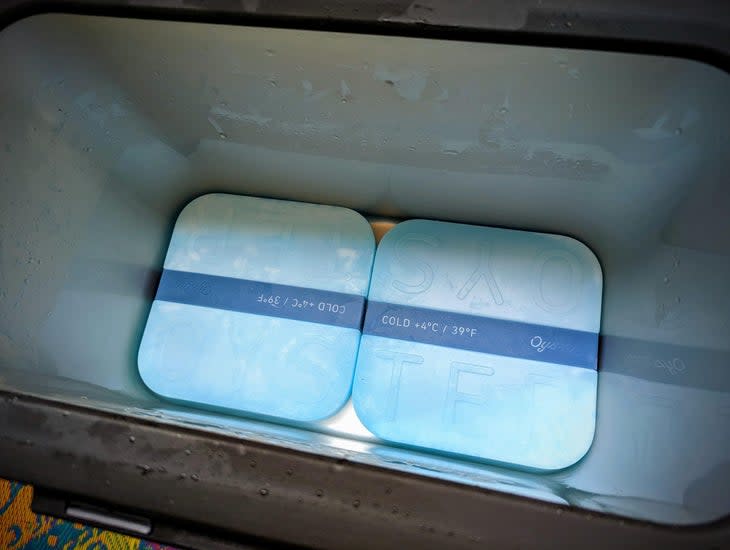
If you've ever used an insulated Thermos or Stanley bottle--or any of the myriad water bottles from brands like Hydro Flask or Yeti--you're already familiar with how incredibly good vacuums are at keeping liquids hot or cold. Case in point: I opened a container of soup after 48 hours on a trail and found it was still too hot to drink. The principal is the same with the Tempo. The cooler is made almost entirely out of aluminum, and the walls are sealed without any air inside. This accomplishes a couple of things. Not only does it do a great job of keeping things cold, but because vacuums are so much more efficient than foam, the walls can be much, much thinner. The result is that for the same internal capacity you get a cooler that is vastly smaller on the outside, and it's a whole lot lighter, too. Polyethylene (which most cooler shells are made of) and foam both weigh a fair amount, whereas aluminum is about 2.5 times lighter as a shell. And vacuums weigh literally nothing.
What Oyster Claims
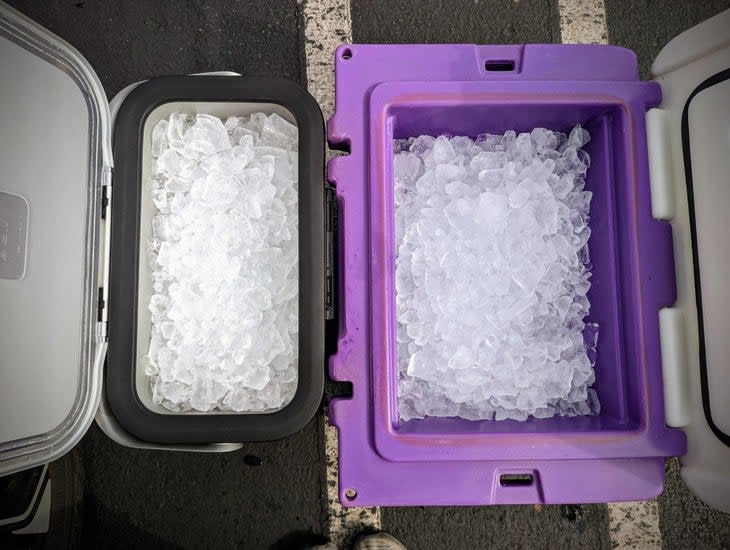
This is where things get wild. According to Oyster, you don't even need to put ice in this cooler. They say you can just toss in cold items and that they will stay cold. I will note that performance will vary greatly in the real world, depending on a number of factors like how cold the items are before you put them in, how much mass they have, and the ambient temperature (I won't bore you with the physics, but items that are colder with more mass will stay cold longer). Better though, is to use the included ice packs. The Tempo comes with two familiar blue squares that are designed to fit perfectly at the bottom of the cooler, maximizing the usable space. With those in the bottom, you can still fit 36 12-ounce cans in the cooler. Most ice chest manufacturers will suggest that you use a two-to-one ratio of ice to food or drink for the best results. To say that cuts into your usable capacity would be an understatement (you lose two-thirds of your space to ice alone), so this really is somewhat revolutionary, if the claims bear out--which we will get to. (And yes, the Tempo can also be used to keep hot things hot, if you so desire.)
How the Oyster Tempo Cooler Measures up to the Competition
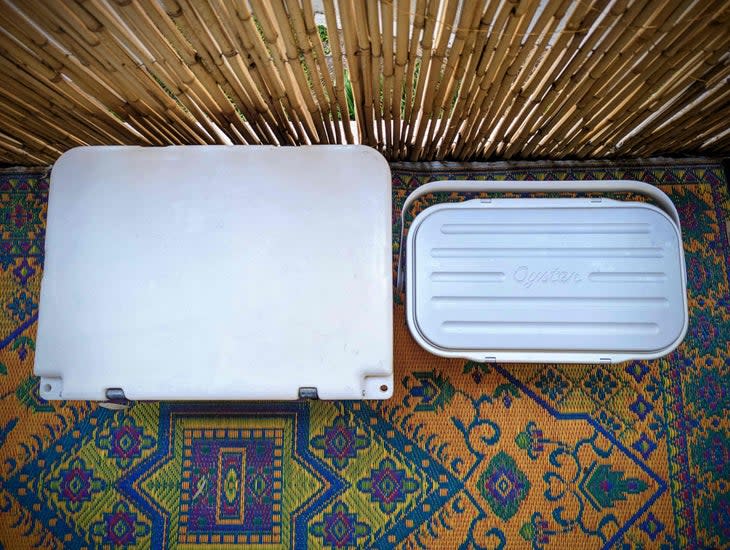
Oyster Tempo
Dimensions: 19.37" W x 12.5" D x 11.57" H, (2,801.4 cubic inches)
Orca 26 Quart
Dimensions: 23.63" W x 17.75" D x14.63" (6,1236.3 cubic inches)
Roadie 24 Liter
Dimensions: 16.6″W x 14.0″D x 17.4″H (4,043.78 cubic inches)
It’s worth comparing some of the specs to roto-molded coolers of a similar capacity, starting with my long-time favorite the Orca 26 Quart ($275). It has slightly more internal capacity than the 23 liter Oyster, but Orca says its cooler can hold just 22 cans with a two-to-one ice ratio. But it's the outside where you really see the difference. Yes, the Oyster is less than half the Orca's size, but with just three liters less carrying capacity. Even Yeti's smallest hard cooler, the Roadie 24 liter,($250) is significantly larger. And it's not just real estate: the Oyster Tempo weighs in at just 12.34 pounds, while the Orca 26 comes in at 25, and the Yeti Roadie 24 weighs 13 pounds.
Notes on Functionality
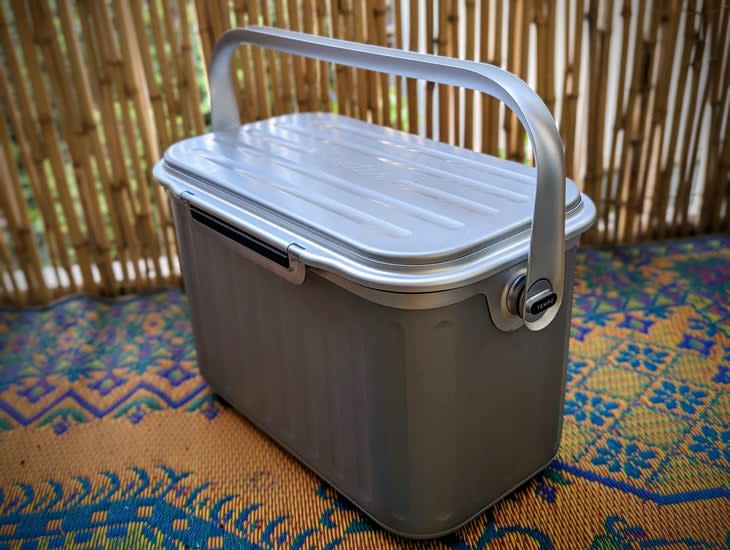
The Tempo includes both an aluminum handle (for carrying by hand) and a nylon strap (to sling over your shoulder), and it's easy to swap between the two. On each end of the cooler is a removable knob (which Oyster calls the "Unimount"); inset the knob, give it a half twist, and you're good to go (just reverse order to remove it.
Make sure the Unimount Key is fully clicked in. I made that mistake and the handle popped out of one side, which caused the cooler to drop and the handle to bend. It was user error, and it was easy enough to bend back into shape, but it would be nice if it were more idiot-proof.
It's nice to have the two carry options, but I found the aluminum handle a bit uncomfortable to use once the cooler was fully loaded. The strap was better, but it was still a bit awkward, because the hard box bumps against your side as you walk. I really wish it had two built-in handles on the side like most rotomolded coolers so I could grip it tightly and lift it high enough so my thighs didn't bump it while walking. This was my least favorite thing about the cooler, but Oyster gave themselves an easy way to fix it: They could just release a pair of individual handles that attach to the Unimounts and instantly eliminate this issue. I, for one, really hope they do.
The lid (which is also fully vacuum insulated), has a latch on the front and the back, so you can easily open it from either side or remove the whole lid, which I thought was a nice touch. And if it gets completely destroyed the whole thing is fully recyclable. Speaking of, it's not bear-proof. Another feature that's missing is a drain. This is part of Oyster's Anti-Ice agenda, and not having a drain hole probably improves the insulation a bit, but it would be a nice option to have. Also worth noting: it's a very handsome cooler, and compared to its roto-molded plastic cousins it looks sleek and compact.
How We Tested the Oyster Tempo Cooler
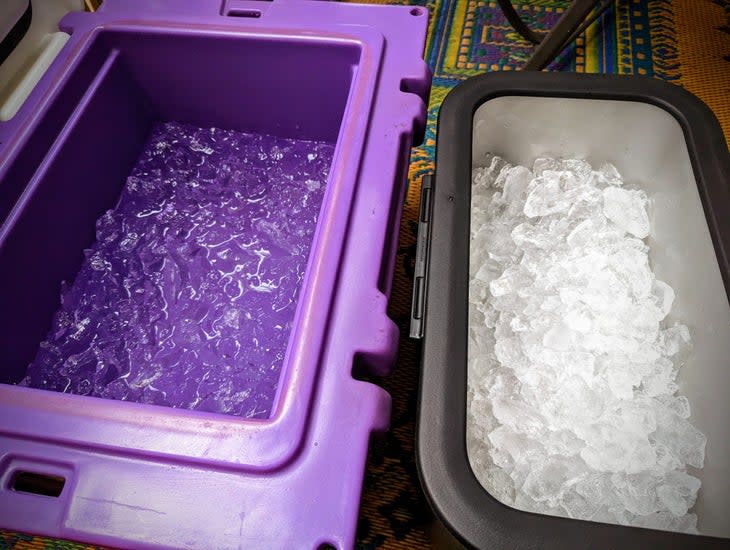
The Oyster Tempo in a head-to-head test with the Orca 26. (Photo: Brent Rose)
Test Number One: No Ice
To evaluate Oyster's claims about the Tempo needing no ice at all I filled it nearly to capacity with 24 cans and bottles of varying sizes along with two full-sized bottles of champagne, all of which started out at 39 degrees Fahrenheit. I kept the cooler in a room at 72 degrees. After six hours, I pulled a can out from the middle, opened it, and stuck a probe thermometer in. It was 44 degrees, which was nice and cold. At 18 hours another can from the same regionhad come up a bit more to 48 degrees, which would still be pleasant to drink on a hot day. At 24 hours the cans were at 50 degrees. Not bad.
Test Number Two: Ice Packs
This time I essentially repeated the test above, but I put the two Oyster ice packs at the bottom. The drinks started out at 38 degrees (room temp was still 72). I didn't do my first check until just after 24 hours had elapsed. I pulled a can up from the bottom and to my surprise it had actually dropped to 33 degrees. Yes, it was touching the ice pack, but that's still impressive. I checked again for a second and final time at just over 52 hours, and the drinks were at 48 degrees. Again, still totally drinkable, but if I'd had some lunch-meat sandwiches in there I think I'd start getting a bit leery-- I certainly wouldn't want to use this method with actual oysters.
Overall, I'd call the results decent, and certainly good enough for a two or maybe even a three-day trip, depending how hot it was. But I wanted to do more of an apples-to-apples comparison.
Test Number Three: Oyster Tempo Versus Orca 26 Liter
For the final test, I pitted the Oyster Tempo directly against my trusted Orca 26 Liter. When I tested coolers recently the Orca dominated the Ice-Melt Test, beating all the other modern roto-molded coolers, retaining some ice for more than a week. So, I threw a 24-pound bag of cube ice into each of them, with nothing else. Both coolers had room to spare, but the Orca had a bit more room at the top thanks to its extra three liters of capacity. I then left both coolers outside, in the shade, on my balcony in Los Angeles, California where temps ranged from 55 to 75 degrees Fahrenheit. The results were fascinating.
At 24 hours, the Oyster was going strong. The ice cubes were still separate and easy to manipulate with my hand. With the Orca, though, the ice had started sticking together and was tougher to break apart. Looking closer, I could see that the ice had melted and shrunk away from the walls a bit, sort of turning it into one big block. This actually backs up one of Oyster's claims: the thin aluminum walls cool off much faster than thicker plastic walls, so it didn't take as much thermal energy from the ice to bring it to equilibrium.
The writing was on the wall early on--the plastic Orca was just melting much faster. The ice wanted to form into a block, and I'd break it up every day. The Oyster was retaining its ice much better, and the cubes stayed looser the entire time (I would break both up each day in the name of fairness). By day seven the Orca had just a few handfuls of ice floating at the top, and by day eight it had completely melted and was a water bath sitting at 46 degrees. More than a week is still an excellent result.
At day eight the ice in the Oyster Tempo was still roughly half cubes and the water on the bottom was a bone-chilling 33 degrees. That is simply an incredible result. It didn't turn all the way to water until midway through Day 11. I would be willing to bet that had I started out with the two blue ice packs on the bottom (which would have fit just fine), it probably would have lasted a full two weeks. It's hard to wrap my head around how efficient that is, and I would most certainly trust it with dairy, meat, and fresh-caught fish.
Final Thoughts
It was definitely annoying that I had to pick it up and dump it afterwards instead of using a drain hole, but it was nice that the lid came off. The fact that the cooler itself is pretty light meant that the task wasn't exactly back-breaking.
I do wish it had better, built-in handles on the sides, and I that it came in more sizes (the 23 liter Tempo is currently the only version available), but it offers unsurpassed performance, and it does so in a smaller, lighter package that's just so much more convenient to use--even with the several drawbacks I noted. I can't say enough how nice it is that it takes up so little space in my garage.
Of course, this all comes at a price, and that price is a whopping $500. That is a lot for a cooler, and way more than the Orca 26 ($275) or the Yeti Roadie 24 ($250), but again, the Tempo outperforms those and does so at 45 percent and 69 percent of their size, respectively. It's worth noting that Oyster isn't the only entrant into the double-wall vacuum-insulated arms race, either. Most notably, Yeti recently launched the V Series. But it currently only comes in a larger 60-liter capacity, it's actually a mix of plastic on the inside and stainless steel on the outside, and it costs $800. It also weighs 34.4 pounds empty, so it's not exactly an apples-to-apples comparison. There are others that are vacuum insulated that are all plastic, like the Dam 35, which only costs $200, but its ice-retention claims are close to that of the roto-molded coolers. Overall, the Oyster Tempo is an impressive first-generation product, with some details that I suspect will be improved in future versions. Whether the stellar performance is worth the price is up to you.
For exclusive access to all of our fitness, gear, adventure, and travel stories, plus discounts on trips, events, and gear, sign up for Outside+ today.

